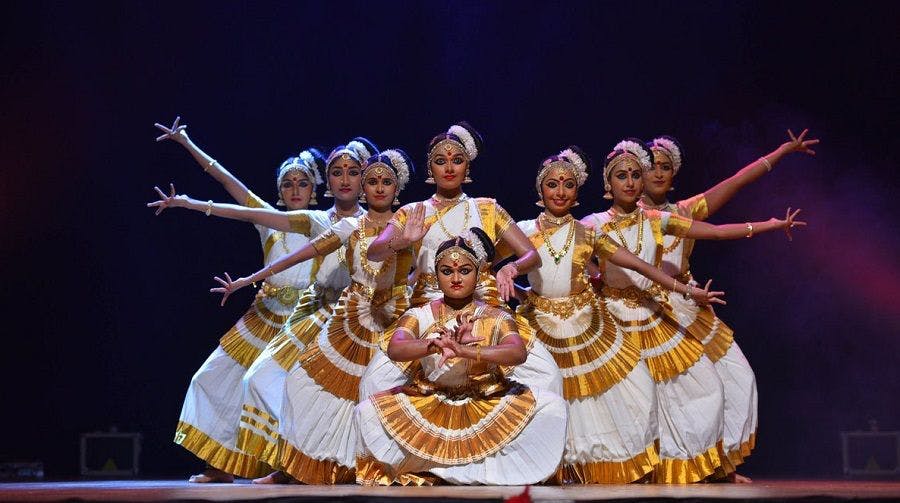Our myths and ancient literature have many references of Mohini and the lasya dance form.
Last week we discussed the story of Vishnu appearing as Mohini in the Palazhi Madhanam story. Some similarities with the Palazhi Madhanam story can be found in Silapathikaram in the following lines:
Tiruvin cheyyolatya pavaiyyum”
The lines describe the dance of a beautiful lady who befuddled and frightened the Asuras with her dance. While the imagery this creates is very similar to the story of Mohini of Palazhi Madhanam, the beautiful lady is often considered as Goddess Lakshmi in the Tamil epic. Irrespective of the context of the story, these references from Silapathikaram indicate the presence of a graceful dance form in regions of Kerala where Silapathikaram originated.
“Cheruvaikolam avunarninka
‘Pavai’ in this context means the beautiful lady. If we go with that meaning, Pavaikoothu, a word extensively used in the literature of those times could be interpreted as a form of the graceful dance of women. Such references could be found in Malayalam literature as recent as the times of Kunchan Nambiar. Kunchan Nambiar refers to ‘penkoothu’ in his works.
In the book “Kerala Charithrathile Atisthanarekhakal’ (Basic records of Kerala History, by MGS Narayanan) certain remarkable references regarding ‘Pavaikkoothu’ can be found. In the Kollam Rameswara Kshetra record (Kollam Era 278, 110 AD) a note indicating an expenditure that occurred for the Tiruppavaikkuttu and Tirukkuthu is found in the third section of the palm leaf records. In those records, Pavaikkuthu is used to indicate a female dance form.
Also, given below are quotes from several articles and books where I came across some references to Mohini as a beautiful dancer:
Mohinippanam
“Mohini is a general term that refers to danseuses in Tamil Nadu too. The term ‘Mohinippanam’ denotes the remuneration given to Mohinis. There is ample evidence to say that Mohinippanam used to be given in Tamil Nadu” – notes Arangil Rekha in the article “Mohiniyattam”.
V S Sarma in his article in ‘Kerala Kalamandalam Trimasika’ (1990) mentions , “Srikanteswaram Padmanabha Pillai defines it as ‘acting gestures of love by wearing the costume of Mohini’. Tamil dictionary refers to the Mohinippanam that is given as offerings when gods dressed as women are brought out”.
Indu Raman, a research scholar of Bhagavatamela referred to the danseuses of Bhagavatamela drama as male Mohini in an interview. Herman Gundert in his dictionary defines Mohiniyattam as “acting like a female”.
Leela Omcheri and Deepthi Omcheri Bhalla in their book “Keralathile Lasyarachanakal” describes:
“The Gollabhama dance of Andhra is believed to be a very ancient temple dance of the Devadasis. Gollabama means a woman who sells milk. It recounts the milk vendor Gollabhama’s travels in the kingdoms of south India and describes through dance, all that she saw in each kingdom. The Kerala she sees is the Kerala of love (Sringara). When she describes the Kerala of love, she praises the dance wherein love is the predominant sentiment (Rasa). The special characteristics of Mohiniyattam stand out even in the lasya movements, costumes, etc and in the gestures that she displays”.
Mohini in the Sangha era
In essence, the lasya dance of Sriparvathi, the Mohini dance that Vishnu performs in the guise as devi and umpteen Mohini sculptures found in Kerala temples, all offer scope for research into the female dance traditions of this part of South India extending all the way up to the Sangha periods. While a single dance form with any particular name may not have existed through the centuries, there is evidence of the continued existence of lasya traditions through the ages and elements of these still exist in the dance and abhinaya traditions of dance forms Mohiniyattam and theatre tradition of Nangiarkoothu. If we unleash our curiosity, we can unravel invaluable information interlaced in all these.
Read Part 3
(Assisted by Sreekanth Janardhanan)

